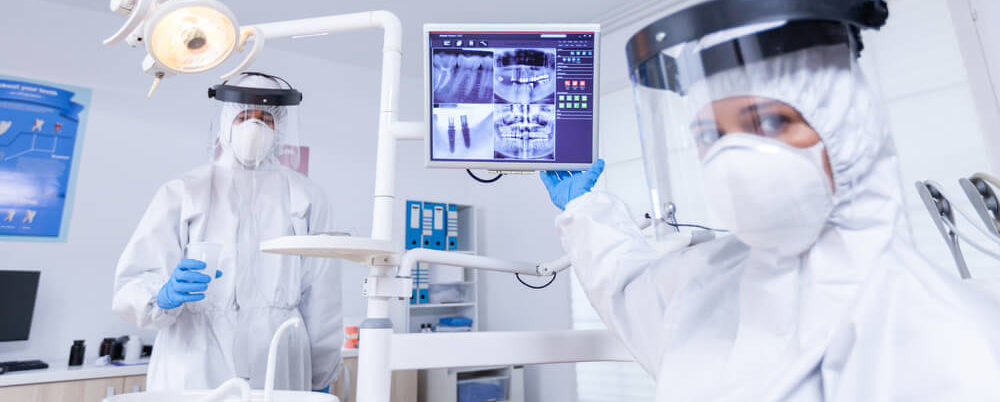
15 Sep How to Report Improper Infection Control Practices in Your Dental Office
Proper sanitation and infection control practices are essential in dental practices to prevent the spread of infectious diseases such as COVID-19, influenza, hepatitis, and more. Many federal agencies, including the Centers for Disease Control and Prevention (CDC) and the Federal Drug Administration (FDA), have guidelines for proper infection control practices in dental offices, colleges of dental medicine, and other dental specialty practices.
The Occupational Safety and Health Administration (OSHA) recently enacted the emergency temporary standard (ETS): Occupational Exposure to COVID-19. OSHA offers some guidance for the ETS as well as dental practice-specific guidance related to COVID-19.
It is vital for your dental practice to thoroughly understand infection control practices to keep patients and employees safe. You must report incidents as soon as possible if you notice an infection control breach in your dental practice. Continue reading to learn more about steps you can take when infection control breaches occur in your dental office.
What Are Common Dental Infection Control Breaches?
Even with infection control regulations and guidelines in place, particular infection control breaches commonly occur in some dental offices. Often, breaches occur during dental instrument cleaning and sterilization. Other common dental infection control breaches happen due to:
Improper Transport and Storage
Properly transporting and storing dental instruments is essential to prevent contamination from blood, body fluids, and environmental factors. Contaminated instruments should be transported in accordance with OSHA standards.
Clean supplies and sterile dental devices could easily get contaminated if they pass by the dirty instrument sink or an ultrasonic cleaner. Some practices, such as leaving instruments on operatory counters, subject them to splashes and splatters during procedures. It is vital to properly transport and store all dental devices such as:
- Syringes
- Handpieces
- Mouth mirrors
- Explorers or sickle probes
- Saliva ejectors
- Scalers
Poor Hand Hygiene
If dental assistants, hygienists, or doctors do not practice proper hand hygiene, they risk spreading infections to patients. Handwashing is one of the best ways to prevent the spread of infectious diseases, so ensure that your staff is thoroughly trained in preventative hand hygiene protocols.
Inconsistent Waterline Care
Dental waterlines are the narrow tubes that connect water to dental instruments. Waterlines must be accurately disinfected so that they remain safe for use on patients. When dental unit waterlines are not disinfected or maintained properly, they become a breeding ground for bacteria, fungi, and protozoa. Keeping waterlines clean is essential for infection control at your dental practice.
5 Steps For Reporting Improper Infection Control Practices
Even though many dental practices and training facilities are stringent about infection control practices, sometimes errors can occur. To prevent improper infection control processes, it is essential to offer extensive training and schedule frequent assessments and gap analyses with an on-site infection preventionist. Implement the following steps if you notice any dental infection control breaches at your office:
1. Keep Records
It is wise to keep individualized medical records of each employee regarding OSHA compliance and training. These records must be reviewed annually, kept up to date, and include the following:
- The employee’s name and social security number
- A copy of the employee’s hepatitis B (HBV) vaccination status, including the dates the vaccine was administered
- A signed vaccination declination form if the employee refuses to get the HBV vaccine or other recommended vaccines
- Copies of medical testing results, follow-up, and the healthcare provider’s written opinion after occupational exposure
Employee medical records are confidential. Keep them locked in a cabinet and do not show them to anyone without the employee’s permission. These records must be kept for the length of the employment term, plus an additional 30 years.
2. Start a Conversation
If you notice one employee in particular who practices substandard infection control, start a conversation with them. If you share how vital infection control practices are, you might help your coworker understand the repercussions of their behavior.
Always aim to foster a culture of safety at your dental office rather than a culture of blame. If you approach the conversation with safety at the forefront, the employee may be more willing to listen and adapt. However, if the employee refuses to listen, share your concerns with the office manager. If an outright breach occurs, you will need to take further action.
3. Perform Basic First Aid
Incidents of exposure should be treated as a medical emergency. If a patient or employee’s skin or eyes were exposed to blood, contaminated needles, or chemicals, they should be evaluated by a healthcare professional immediately.
After any exposure, perform basic first aid. Depending on where the exposure occurred, follow these safety steps:
- Immediately flush eyes or mucous membranes (nose and mouth) with water
- Wash infected skin with soap and water
- Bandage any open wounds or cuts
4. Report to Your Designated Infection Control Coordinator
Suppose you witness an infection control breach from another employee or by your own hand. In that case, you must report the incident to the designated person in your clinic or practice. This is usually a supervisory person who generally helps with any required paperwork and directs the employee to the appropriate facility for an exposure evaluation.
According to the OSHA Bloodborne Pathogen standard, the following information must be recorded after an exposure:
- The date and time of exposure
- Details about how the incident occurred
- The type of exposure (percutaneous or mucous membrane splash)
- The severity of the exposure
- If any safety devices were used
- Whether the source material was known
- The exposed person’s vaccination record
The exposed patient or employee should bring the report to their medical evaluation so that a healthcare provider can assess the risk of the exposure and recommend treatment. It is essential to report all instances of exposure breaches, even if they only seem minor. Failure to report seemingly insignificant cases can delay necessary medical attention.
5. File Additional Reports
Beyond notifying your designated infection control coordinator, you may file additional reports if you are concerned about breaches. Further actions you can take include:
- Contacting your state or local regulating authorities in your jurisdiction
- Notify your state or local health department’s oral health program
- File a complaint with your state dental board
- Inquire with your state dental association about dispute resolution
If you believe worker safety has been compromised, reach out to your local or state agency that enforces occupational safety and health regulations. Completing these additional steps will help ensure that all employees in your dental practice are thoroughly trained to prevent future breaches from occurring.
Prioritize Dental Infection Control to Limit Breaches
The most effective way to limit exposure breaches is to prioritize dental infection control training. All dental practice employees should be thoroughly and regularly trained on instrument cleaning and sterilization techniques, proper transport and storage, hand hygiene, and waterline care. If an infection control breach occurs in your office, report it to your designated infection control coordinator immediately, even if it seems minor.
If you want to increase dental infection control education at your practice, reach out to Infection Control Results to request a consultation. Our knowledgeable infection preventionists can help keep your employees and patients protected from healthcare-associated infections.

